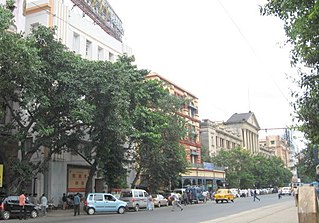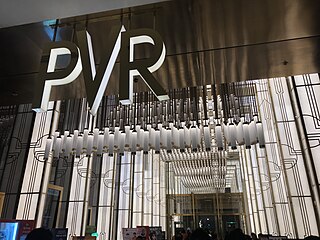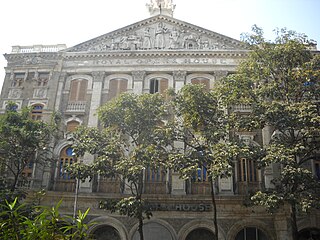
Metro INOX Cinemas is an Art Deco Heritage grade IIA multiplex Movie theatre in Mumbai, India built in 1938. It was built and originally run by Metro-Goldwyn-Mayer (MGM). The main architect of the cinema was Thomas W. Lamb of New York City, and D. W. Ditchburn of Mumbai was the associate architect. It was one of the main sites targeted in the 2008 Mumbai attacks.

Esplanade is a neighbourhood of Central Kolkata, located at the heart of city with being the city's Central business district. This is a conventional esplanade because the Ganga river (Ganges), also known as Hooghly river, flows nearby and it is adjacent to the large fields of Maidan extending up to Fort William.

The culture of Kolkata concerns the music, art, museums, festivals, and lifestyle within Kolkata. It is the former capital of India and, as of 2021, the capital of the Indian state of West Bengal. Geir Heierstad writes that Bengalis tend to have a special appreciation for art and literature.

Tollygunge is a locality of South Kolkata, in West Bengal, India. It is known for being the center of Indian Bengali-language cinema, with filming locations used for other regional Indian films.

PVR INOX Ltd, formerly known as PVR Cinemas, is an Indian multiplex chain based in Delhi. It was formed as a result of the merger between PVR Cinemas and INOX Leisure Multiplex. PVR pioneered the multiplex revolution in India by establishing the first multiplex cinema in 1997 at Vasant Vihar, New Delhi. In 2022, PVR Cinemas achieved the milestone of completing 25 years in the business. As of December 2023, PVR Inox has 1747 screens across 359 properties in 114 cities.

Royal Opera House, more commonly known simply as Opera House in Mumbai, is India's only surviving opera house.

Cinema of West Bengal, also known as Tollywood or Bengali cinema, is the segment of Indian cinema, dedicated to the production of motion pictures in the Bengali language widely spoken in the state of West Bengal. It is based in the Tollygunge region of Kolkata, West Bengal, India. The origins of the nickname Tollywood, a portmanteau of the words Tollygunge and Hollywood, dates back to 1932. It was a historically important film industry, at one time the centre of Indian film production. The Bengali film industry is known for producing many of Indian cinema's most critically acclaimed global Parallel Cinema and art films, with several of its filmmakers gaining prominence at the Indian National Film Awards as well as international acclaim.
Big Cinemas was an Indian movie theater chain. It was a division of Anil Ambani’s Reliance MediaWorks Ltd and a member of Reliance ADA Group.

Aki Narula is an Indian fashion designer, costume designer and wardrobe stylist in Hindi films, who is most known for films like Bunty Aur Babli (2005), Don - The Chase Begins Again (2006), Jhoom Barabar Jhoom (2007) and Dostana (2008). His brand label "AKI" was launched in 1996.

Cinema of South India, refers to the cinema of the four major film industries in South India; primarily engaged in making feature films in the four major languages of the region, namely — Telugu, Tamil, Malayalam and Kannada. They are often colloquially referred to as Tollywood, Kollywood,Mollywood and Sandalwood, respectively.

Sterling Cineplex is a multiplex cinema hall in Mumbai. Opened in 2007, Sterling has three screens and was the first cinema in India to be THX certified. It is considered a landmark in South Mumbai.

Metropolitan Building is a commercial building on Chowringhee Road in Kolkata near Esplanade. Formerly known as the Whiteaway Laidlaw department store, it was a famous department stores in Calcutta during the British Rule in India. It is one of the first departmental store in India. This neo-baroque emporium—with domes, a clock tower and arched recessed windows—exemplifies fashionable shopping during the British Raj in British India.

Priya Cinema is a uniplex cinema hall situated in Rashbehari Avenue, near Deshapriya Park, Kolkata, West Bengal, India. The management is run by Priya Entertainments Pvt. Ltd. under the leadership of the managing director Arijit Dutta. This is one of the first cinema halls in eastern India to have features like a Dolby Atmos [(sound system)], Xenon Christie projector, Recliner seats, QUBE digital projection system, Harkness Screen and 2K Projection System.
Lighthouse Cinema was a single screen cinema hall and heritage building located in Humayun Place in New Market, next to New Empire, Kolkata, West Bengal, India.

Maratha Mandir is a cinema hall located in Maratha Mandir Marg, Mumbai, India. It opened on 16 October 1958 and has 1000 seats. In the 1960s and 1970s, it was known for its lavish film launches, but the introduction of multiplexes diverted "class" viewers from establishment with the "masses" of the working class patronizing the theatre instead. It is currently known for holding a record after screening the film Dilwale Dulhania Le Jayenge for 1009 weeks since its release in 1995, on 19 February 2015. As of September 2019, the film has been running for a continuous 1230 weeks. This cinema hall is one of the famous landmarks in Mumbai.
The Art Deco in Kolkata, India is a prominent architectural style which can be found across the city, most notably in the southern parts of the metropolis. The style can be traced back to the 1930s "with the use of Portland cement and with geometrical articulation in plan and cosmetic decorative treatment including perforated concrete grill-work on a simple elevation (façade)." Although Kolkata is notable for its colonial-style and vernacular-style buildings, the emphasis on Art Deco buildings while discussing the architectural history of the city is often overlooked. This is in exception to the few prominent art deco buildings constructed during the colonial period in the first half of the twentieth century—about which enough has been written. Despite art deco being so prominent in the latter half of the twentieth century insofar as entire neighbourhoods—architecturally speaking—appeared to be adaptations of one style, it was not paid enough attention up until the twenty-first century when many such buildings started to be either severely neglected or demolished because of lack of architectural and historical awareness and preservation efforts.
















